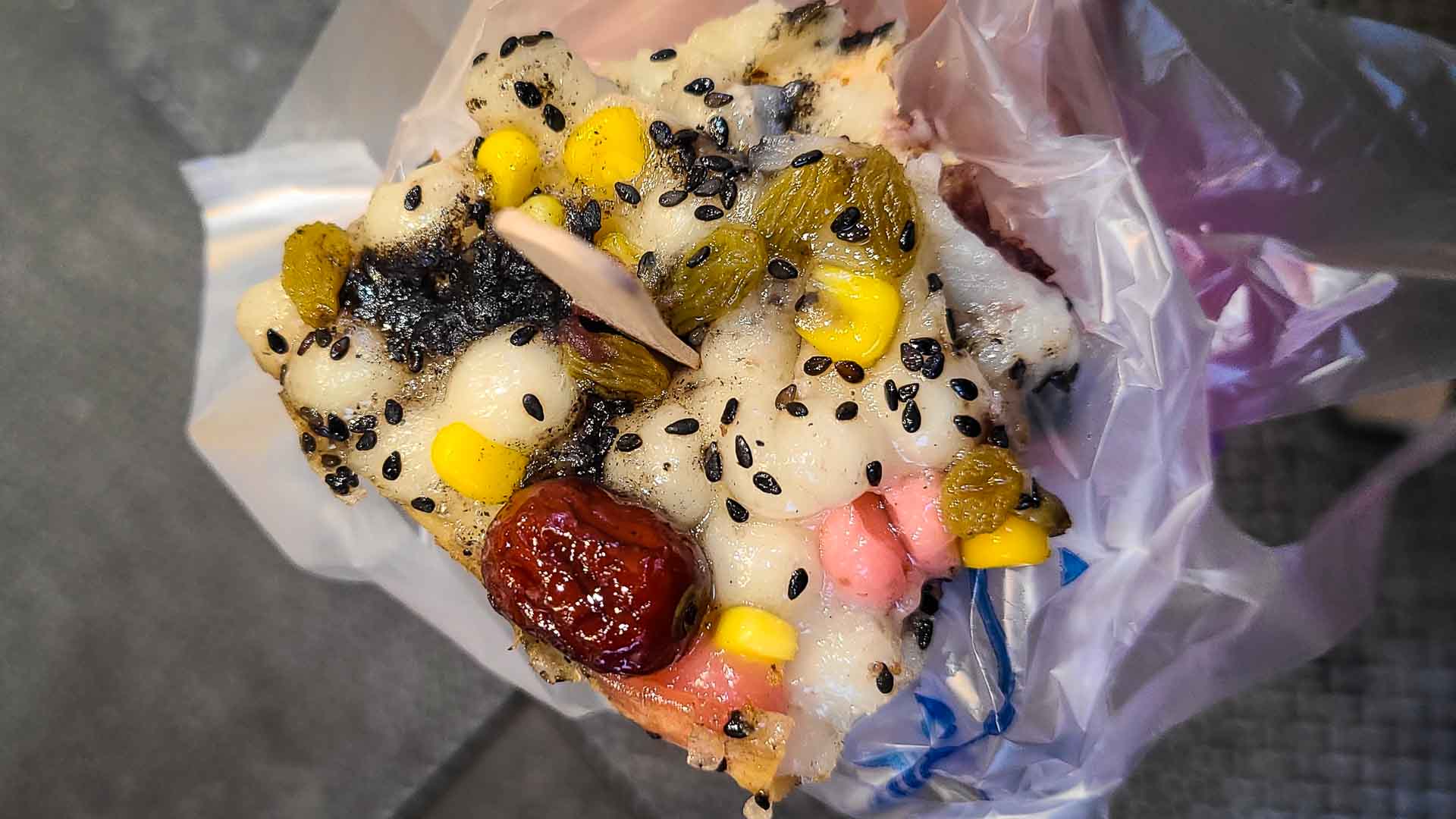
Yep, it took me nearly half my life to finally make a visit to Asia. I’m currently writing this from my months-long stay in Taipei, Taiwan. As a Type 1 diabetic and world wanderer, I’ve obviously had to figure out my fair share of culinary challenges when traveling outside of the U.S. But let me tell you, Taipei—or Asian food more specifically—has thrown me for a loop with its sneaky sugar game.
Side note, during my time here in Taipei I’ve been managing my Type 1 Diabetes on a Tandem t:slim x2 insulin pump on a closed loop with Dexcom G7 continuous glucose monitors.
A Not-So-Sweet Surprise—There’s A Lot Of Added Sugar In Asian Food!
About a month before my first trip, I was talking to my partner about how Pad Thai is my favorite comfort food, but that it makes my blood sugars completely skyrocket even more than I expect. She calmly and casually responded “Well, you know they add sugar to it right? It’s not just the noodles. Lots of Asian food has sugar added to the sauces…” Mind…blown.
“You can’t taste the sugar in it?” Honestly, no, I’ve never really tasted it! But now that it was pointed out to me I had to go digging on the interwebs for more.
Turns out it’s true—added physical sugar is a real thing in a lot of Asian food, especially more casual finds and in places like night markets, where locals and tourists often go for an evening of casually eating from stall to stall. I’ve definitely seen it…and experienced the glucose level spikes…while living as a Type 1 in Taipei, Taiwan for a few months now.
Contents (tap + at right)
This site participates in the Amazon Services LLC Associates Program and other affiliate programs and may earn from qualifying purchases. You’re never charged more, but it helps out little by little! Check out “Privacy” in the top menu if you need to know more!
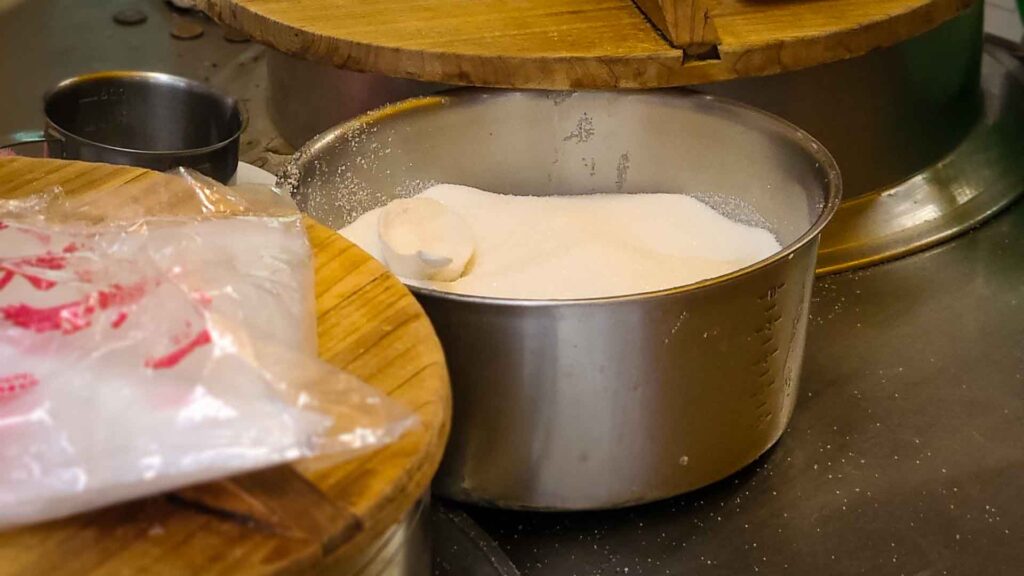 A giant bowl of white granulated sugar on a night market counter in Taiwan for adding to the food before it’s served!
A giant bowl of white granulated sugar on a night market counter in Taiwan for adding to the food before it’s served!
Is That Literally A Bowl Of Sugar I See?
Yep. Just to hit you with the possible reality up front, that picture is literally a bowl of white granulated sugar sitting at the food prep/bagging station of one of the cheap, local breakfast restaurants I frequented.
It’s not unlikely to see this at a mom-and-pop local spot out in the open, used to sweeten many different dishes. But this should serve as a warning as to what could be happening behind the scenes at any asian food spot.
I’ve seen them casually grab a spoonful of white sugar and chuck it in soups before serving, or even sprinkle it over rice or other dishes before packing or serving. Watch out!
Disclaimer: This diabetes blog is based on my personal journey managing type 1 diabetes. Everyone’s type 1 diabetes journey is unique, and what works for me might not work for your situation. I’m not a medical pro, The info here isn’t a substitute for professional medical advice, diagnosis, or treatment. Talk with your doctor before making any decisions regarding your diabetes care. – Jason 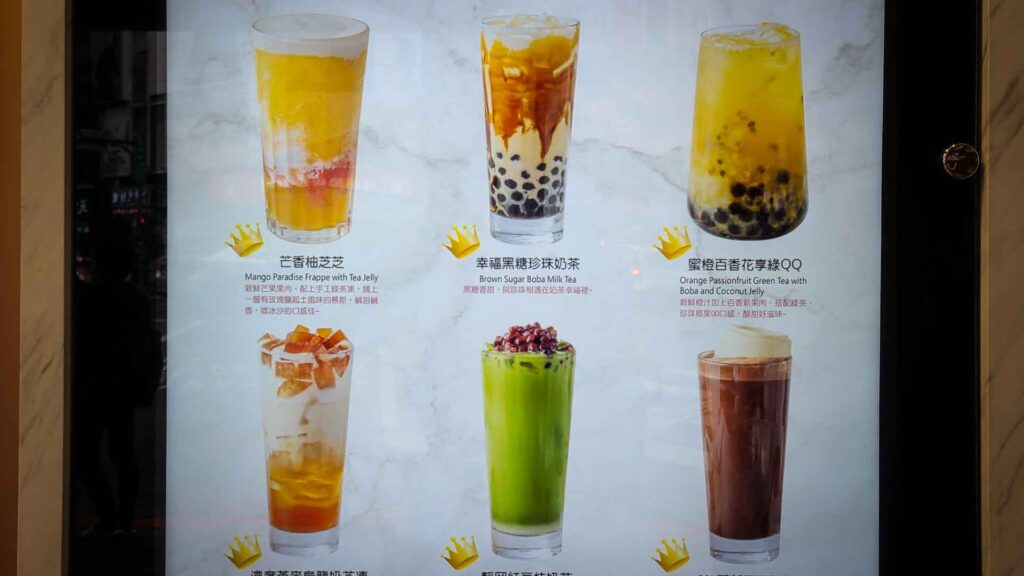 Colorful glasses of Boba Milk Tea (sometimes called bubble tea) on a menu in Taiwan
Colorful glasses of Boba Milk Tea (sometimes called bubble tea) on a menu in Taiwan
Sweet, Sweet Bubble Tea – Pick Your Sugar Level
First up, let’s talk about one of Taipei’s most iconic beverages: boba tea…or bubble tea if ya nasty. If you’ve done or thought of traveling to Taiwan, you’ve no doubt seen it. And seeing as it’s kind of a big deal in the U.S. right now, maybe you’ve had one.
Me, I tasted it once a year or so ago in the U.S., but it was so sweet I pretty much swore it off. So when I got to Taipei I didn’t plan on having any.
Those cute, delicious tapioca pearls are often swimming in a sea of syrup. But did you know that you can adjust the level of sweetness when you order your bubble tea…and many other sweet drinks in Taiwan?
Bubble tea shops in Taipei often offer a range of sweetness levels, allowing you to customize your drink to your taste preferences. Ordering a lower sweetness—or even sugar free—bubble tea, can help you enjoy this local treate without the blood sugar spike.
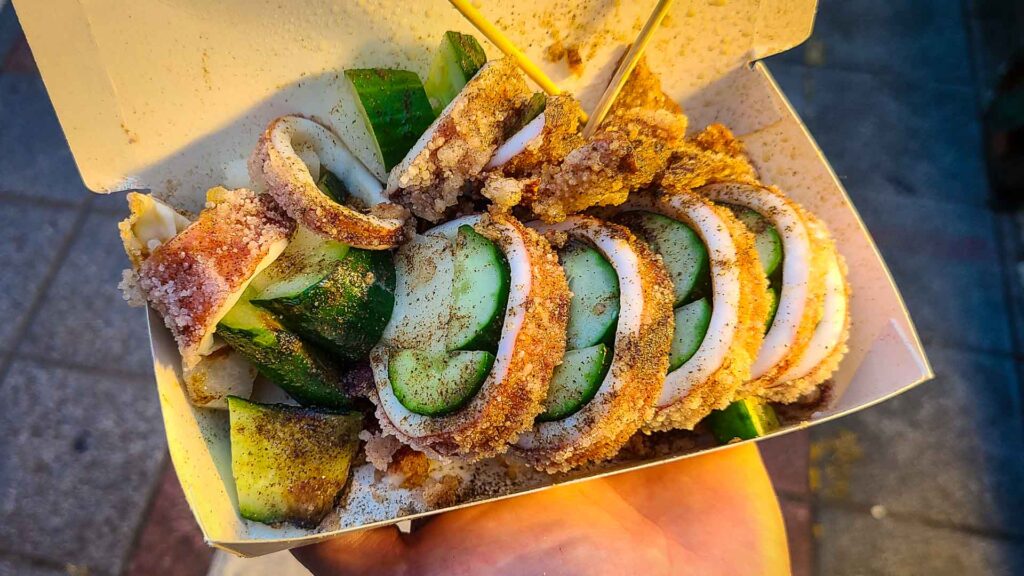 Stuffed and fried whole squid from Ningxia Night Market in Taipei—the spices & sprinkles were laced with sugar!
Stuffed and fried whole squid from Ningxia Night Market in Taipei—the spices & sprinkles were laced with sugar!
Connect & Share This Article
Dumplings, Dumplings Everywhere
And then there are the dumplings. Who knew those innocent-looking dumplings could be hiding extra sugar beyond the carby exterior? From savory fillings to sneaky sauces, traditional Taiwanese bites can catch you and your type 1 diabetes off-guard if you’re not paying attention.
Pro-Tip
Stick to steamed dumpling options and ask for sauces on the side so you can taste them first to decide (or guess) how much sugar might be in them. Then bolus accordingly.
Some dumpling fillings may contain added sugars, while certain sauces, like hoisin or sweet soy sauce, can contribute to the overall sugar content of the dish.
By being mindful of these factors and opting for simpler, less saucy options, you can enjoy dumplings without worrying about your blood sugar levels.
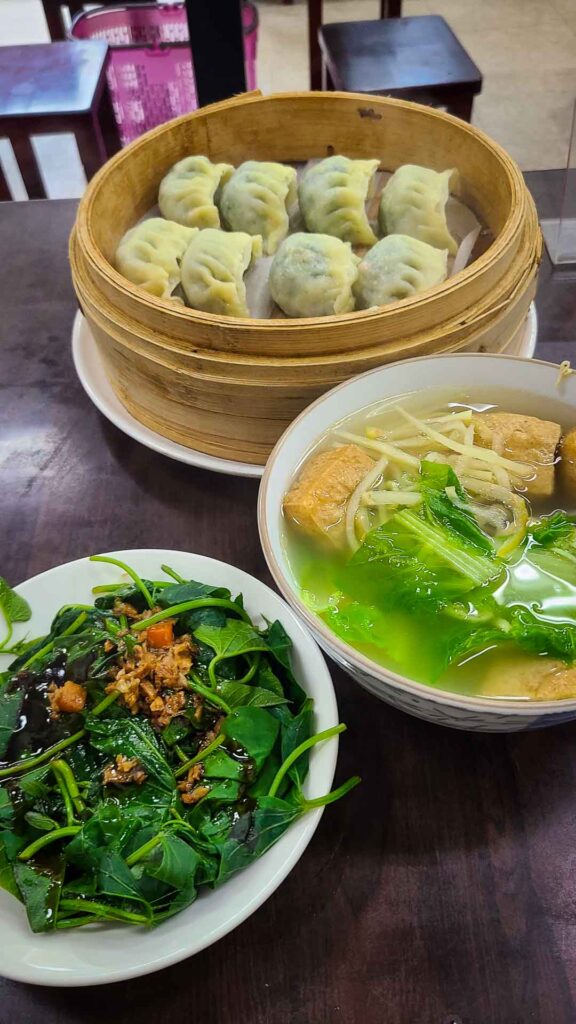 Steamed dumplings and soup…and a whole mess of greens
Steamed dumplings and soup…and a whole mess of greens
And let’s not forget about stir-fries. Stir-fries might seem like a safe bet, but those tasty sauces can also be loaded with sugar.
In Asian food, stir-fries are often prepared with a variety of sauces, including soy sauce, oyster sauce, and hoisin sauce. While these sauces add flavor to the dish, there’s a good chance they use sugar in the recipe and your blood sugar could spike because of it. When ordering stir-fries, consider requesting sauces on the side or asking for lighter sauce options to help control your sugar intake.
 How Fuzhou Pepper Buns cooks their famous Pork Pepper Buns at Raohe night market in Taipei, Taiwan
How Fuzhou Pepper Buns cooks their famous Pork Pepper Buns at Raohe night market in Taipei, Taiwan 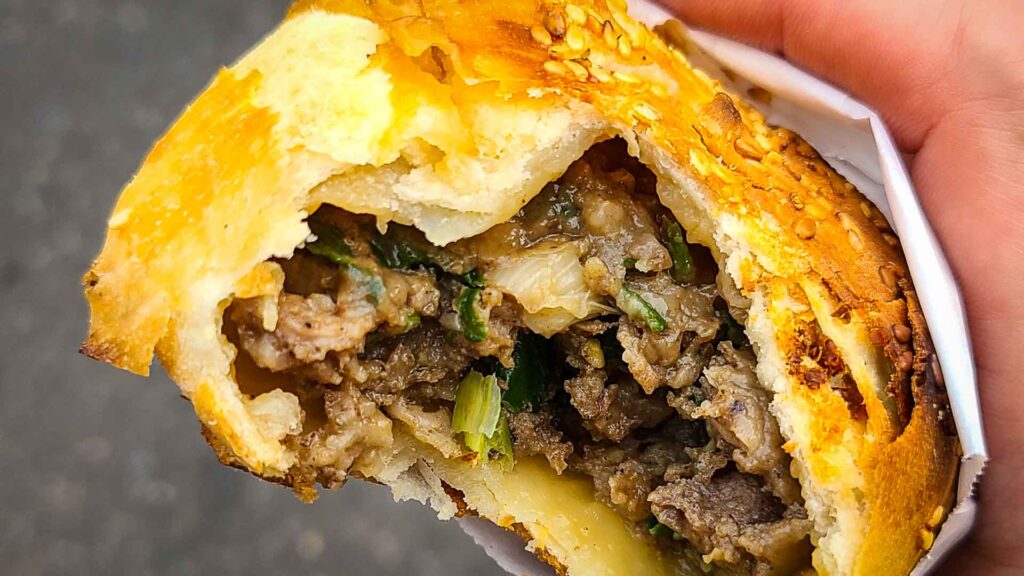 A Fuzhou Pork Pepper Bun from The Famous Raohe night market in Taipei, Taiwan
A Fuzhou Pork Pepper Bun from The Famous Raohe night market in Taipei, Taiwan
READ NEXT: Gifts For Diabetic Travelers—Essential Travel Items & Unexpected Gifts
I Just Got Diagnosed With Diabetes And I’m FREAKING OUT!
Menus, Translations, And Super-Helpful Phrases
Now let’s talk about navigating menus. Trying to decode menus in a foreign language is like playing a game of culinary charades. That said, some of my best laughs have come from seeing what Google Translate gives me when translating a menu, lol. Let’s just keep it at NSFW! But a few key phrases can go a long way in helping you navigate it as a Type 1 diabetic.
Helpful Chinese Phrases For Ordering Food As A Diabetic
- bù yào táng – no sugar
- qǐng wèn táng dù – please reduce the sugar
- jiǎn táng – less sugar
- Wǒ huàn yǒu tángniàobìng – I’m diabetic
Do I use those phrases often? Honestly, no. Because every time I’ve tried to pronounce anything in Chinese, I’m way off, and it just fails. For me, it’s really just a matter of avoiding or just bolusing (on extended bolus for sure) accordingly, tasting, and adjusting.
 Stuffed and fried whole squid from Ningxia Night Market in Taipei
Stuffed and fried whole squid from Ningxia Night Market in Taipei
Sweets Are Less Sweet Than Expected
That’s a really general statement, but I’ve found it’s true. While certain things like boba tea—in their most pure, sweetest forms—are really sweet, I’ve found that a lot of desserts and “sweets” area actually less sweet than in the states. I was literally chatting with a non-diabetic last night and he gave that same opinion without prompting. And my partner who lives in Taiwan has mentioned the same thing.
So if I order a tiramisu (my favorite dessert), get some chocolates or other sweets from the 7, or get what looks like a sugary treat from a local bakery, I’ve had to bolus much less than expected. Well…after quite a few weeks of going low because I was using “what I knew” of those treats from living in the United States.
Honestly, for the first month or so I went low a lot because I was bolusing for these types of sweets the same way I would in the U.S.
Lesson learned.
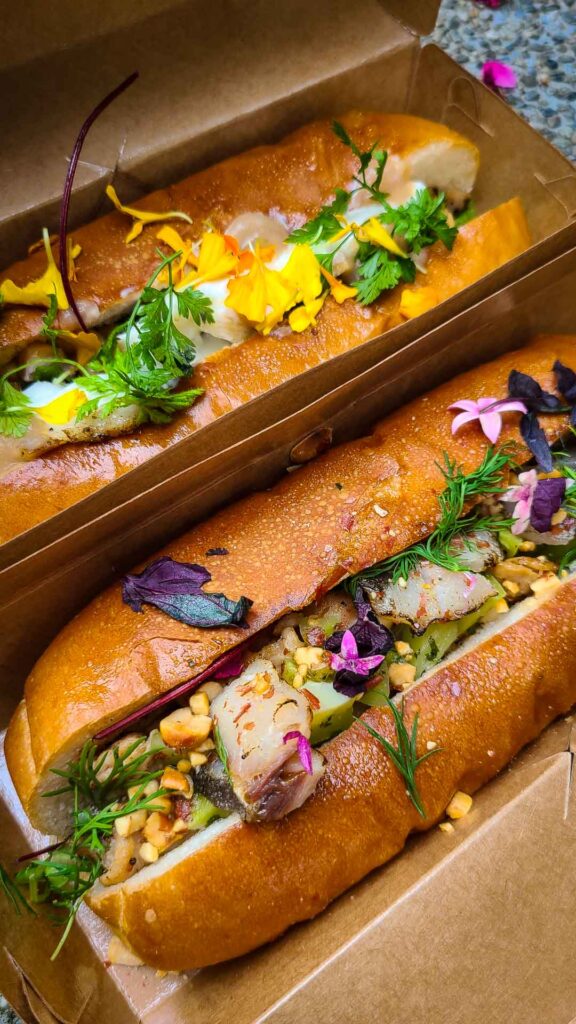 An inspired banh mi from a Nomad food truck in Taipei
An inspired banh mi from a Nomad food truck in Taipei  Flaky baked Gua Bao buns at a night market in Taipei. This version of the Taiwanese hamburger blew my mind!
Flaky baked Gua Bao buns at a night market in Taipei. This version of the Taiwanese hamburger blew my mind!
Veggies To The Rescue…Lots And Lots Of Veggies
I prefer eating mostly vegetarian, but as a person who’s not traveled the world much, I also want to try all the things when traveling to new places. So I tend to get a decent mix of meat proteins with my veggies when in a new place. No different here in Taipei.
One of the real surprises for me during this first time in Asia is the difference in the amount of rice I’m eating compared to what I expected—much, much less.
 Taiwanese hot pot dinner for four—notice there’s not actually a bowl of rice on the table!
Taiwanese hot pot dinner for four—notice there’s not actually a bowl of rice on the table!
Turns out in the U.S., Asian takeout food seems to have rice as the cornerstone, but what I’ve seen here is that it’s actually much less of a standard. I’ve noticed that a single bowl of rice, maybe a cup in size, is often shared by 2-4 people over an entire meal.
So I’ve really had to use extended boluses and bolus a little lower than expected, since I’m actually eating less carb-heavy than I anticipated when traveling to Asia. Between extended boluses and automatic basal adjustments from my pump, it’s been relatively easy to navigate.
 Making squid balls at a night market in Taiwan.
Making squid balls at a night market in Taiwan.
Good Luck Eating In Taiwan!
So there you have it, my crash course on navigating the sugar-laden streets of Taipei. Again, it’s actually been the opposite of how overwhelming I thought the food game would be here with my Type 1 diabetes managment.
The rice and noodle carbs haven’t been that big of a deal, especially with a fatty protein included, like the fatty pork often found. But the hidden and added sugars in sauces, and the seemingly less sweet desserts and baked delicacies, have been the hardest to adjust for because it’s a little counter-intuitive to what I was expecting.
My suggestion for you?
Just go slow, pay attention to how foods hit you, and adjust!
Good luck, and enjoy—Cheers!
Connect & Share This Article
READ NEXT: Gifts For Diabetic Travelers—Essential Travel Items & Unexpected Gifts
PS – You can check out more products recommended for long-term travel and daily life with diabetes here.
RELATED ARTICLES:
Gifts For Diabetic Travelers—Essential Travel Items & Unexpected Gifts
I Froze My Insulin Flexpens—Tips For Traveling With Insulin Internationally
I Just Got Diagnosed With Diabetes And I’m FREAKING OUT!
Diabetes Symptoms For Noobs – My Type 1 Diabetes Symptoms & Diagnosis Story
Connect & Share This Article
Please visit:
Our Sponsor
